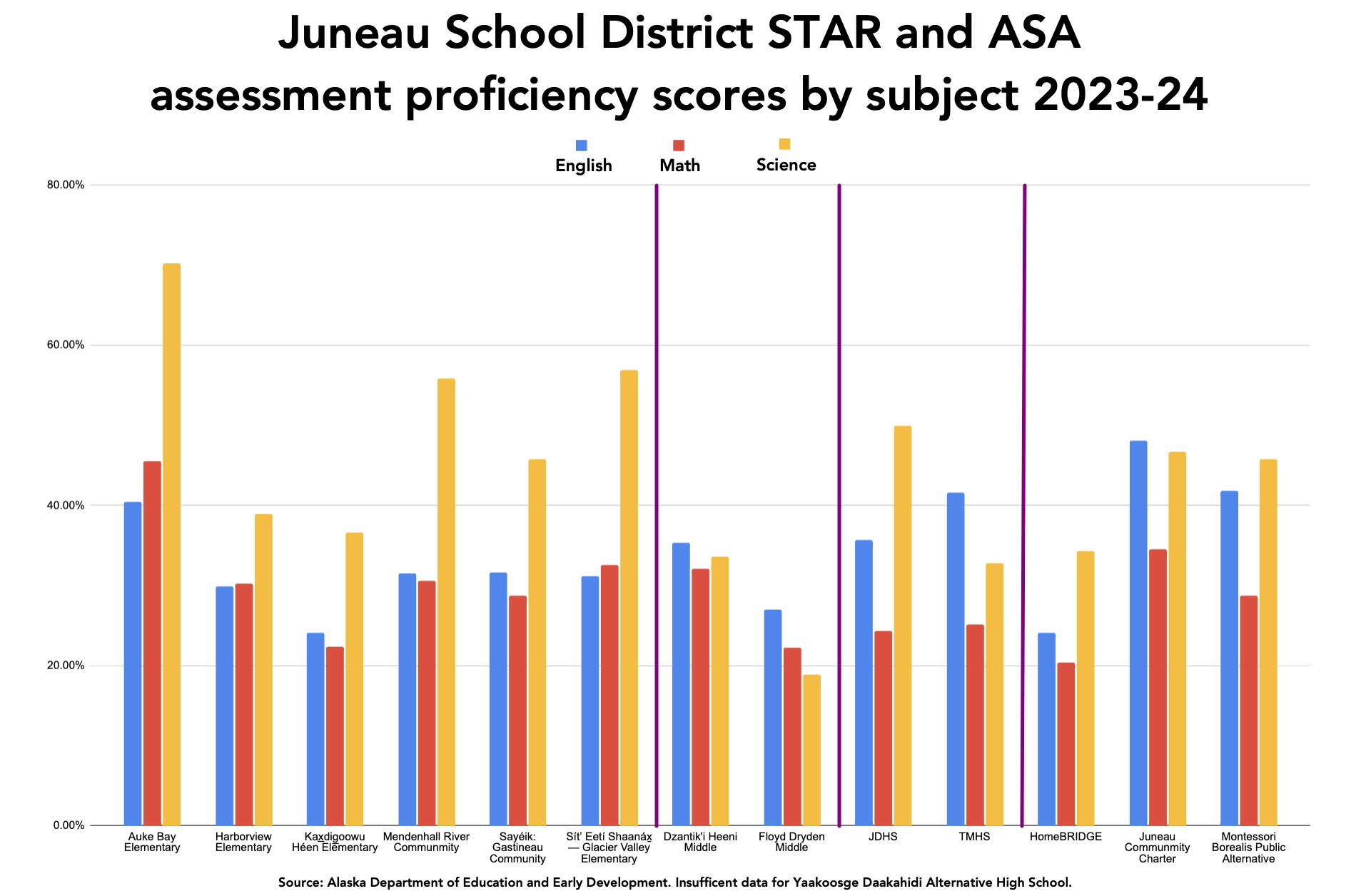This story has been updated with comments from the Juneau School District.
Juneau students are slightly above the statewide average in English and science assessment scores released Friday, and slightly below in math, but there are drastic differences in local proficiency scores by school and grade levels within schools.
Math and science proficiency scores are roughly twice as high at Auke Bay Elementary School as Kax̱dig̱oowu Héen Elementary School, for example.
Meanwhile, within Floyd Dryden Middle School proficiency in English dropped from 33.04% of students in sixth grade to 27.61% in seventh grade and 19.81% in eighth grade — one of many examples where results fluctuated up or down by a significant percentage.
And in the final comparison of Juneau’s two high schools before they were consolidated into one for this school year, Thunder Mountain High School had higher student proficiency scores in English and math, while Juneau-Douglas High School: Yadaa.at Kalé has a higher science score.
The scores are from the Alaska System of Academic Readiness (AK STAR) assessments for English and math for grades 3-9, and the Alaska Science Assessment for grades 5, 8 and 10. A total of 62,052 students participated in those assessments during the past school year, according to the Alaska Department of Education and Early Development.
“The Juneau School District is reviewing district and school data and will be sharing out information with the community. Families will receive individual student test results by September 27, 2024,” Kristin Bartlett, the district’s chief of staff, wrote in an email Friday in response to questions from the Empire about the results. “The Board of Education will look closely at this data, along with other indicators of student success, at a work session scheduled for November 12, 2024.”
As in the past two years the tests have been administered, well under half of students statewide and in Juneau were deemed advanced or proficient in the three testing subjects, the department reported. Statewide 31.8% of students scored proficient or better in English, 32.5% in math and 36.9% in science, while in Juneau those respective percentages were 33.35%, 29.05% and 39.78%.
“Upper grades, particularly 8th and 9th, continue to require improvement,” a press release issued by the department states, referring to the statewide results. “Efforts are underway to enhance reading skills, support school improvement, and offer career and technical education pathways to elevate achievement across all grades.”
Bartlett, in her email, noted the STAR assessments are relatively new and “had some substantial reworking accomplished by the state; results for Spring 2023 were not even released until April of 2024. The validity of year-to-year comparisons may therefore be limited.”
Criticism that flat state education during the past decade is a factor in the test scores was expressed in a joint statement by the Alaska Council of School Administrators (ACSA) and Association of Alaska School Boards (AASB).
“The results of the AK Star Assessment indicate that Alaska’s students are making gradual progress, but they still face significant challenges,” AASB Executive Director Lon Garrison said in a prepared statement. “It’s no surprise that with limited resources, local school boards struggle to improve student success. To achieve the state’s goal of providing an excellent education for every child every day, it’s crucial for the State of Alaska to make deliberate and sufficient investments, and for local governance to be effective, along with the implementation of high-quality curriculum and instruction.”
The joint statement also notes that, while there are high statewide participation rates among students attending neighborhood schools and charter schools (94.4% English, 94.2% math and 89.9% science), “it remains difficult to evaluate correspondence performance statewide, with only 14.7% participation in English and 14.6% Math and 10.5% for science.”
In response to a question about the difference in test scores among Juneau’s schools, Bartlett stated “each JSD school goes through yearly action planning and goal setting to respond to areas of their unique student needs. These test results give schools another piece of data to use to evaluate their progress.”
“JSD strives for all students to meet grade level standards and make individual growth targets each year at every school and grade level,” she wrote. “The district provides a consistent curriculum and instructional program across all our schools to provide a framework for what students learn each year at all schools. JSD also continues to focus resources toward targeted interventions that will provide the most support for students at all levels.”
Among the items of note in Juneau’s results by school:
• Floyd Dryden Middle School had the lowest overall proficiency scores with 27.04% in English, 22.25% in math and 18.87% in science. Dzantik’i Heeni Middle School fared far better with 35.51%, 32.10% and 33.62%, respectively. Also, both middle schools — which have been consolidated into the building used last year by TMHS — saw large drops in scores for seventh-graders compared to sixth graders.
• Auke Bay Elementary and Mendenhall River Community schools both saw significant increases in proficiency scores from grades three to five. But Harborview and Kax̲dig̲oowu Héen elementary schools saw notable declines in fourth grade English and/or math scores compared to third- and fifth-grade students.
• Scores at alternative education programs tended to vary widely in part due to fewer students, which meant a few student scores could significantly alter the curve. There were not enough results for the alternative Yaakoosge Daakahidi High School to return results other than “40% or fewer” students were proficient at English and math, and 20% or fewer proficient at science.
• Contact Mark Sabbatini at mark.sabbatini@juneauempire.com or (907) 957-2306.

